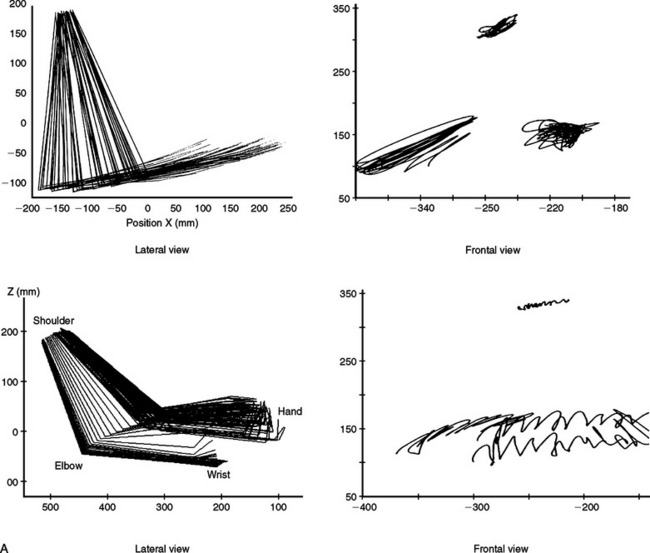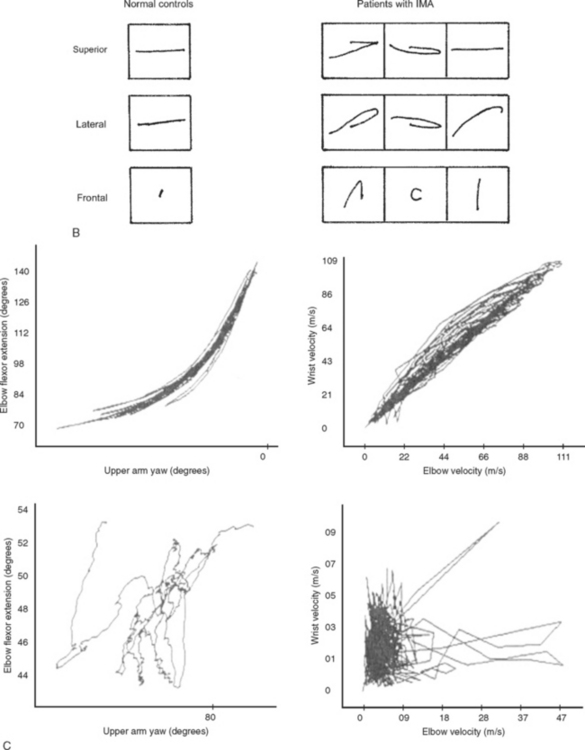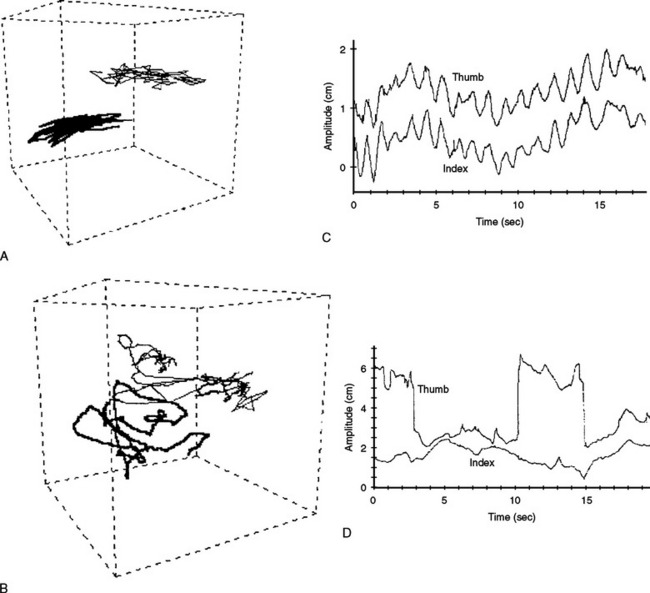CHAPTER 32 APRAXIA
Apraxia is one of the more frequent consequences of brain damage and can lead to severe disabilities in daily life. The term apraxia covers a wide spectrum of higher order motor disorders caused by acquired brain disease that affects the performance of skilled, learned movements with or without preservation of the ability to perform the same movement outside the clinical setting in the appropriate situation or environment. The disturbance of purposive movements cannot be termed apraxia, however, if it results from a language comprehension disorder or from dementia or if the patient suffers from any elementary motor or sensory deficit (i.e., paresis, dystonia, ataxia) that could fully explain the abnormal motor behavior.1–3
Apraxia is found mostly in patients with stroke, but the disorder can result from a wide variety of other focal lesions (i.e., trauma, tumors) or from diffuse brain damage as observed in Alzheimer’s disease or corticobasal degeneration.2
LIMB APRAXIAS
Hugo Liepmann originally posited that the idea of the action, or movement formula, containing the space-time picture of the movement, was stored in the left parietal lobe and that in order to carry out a skilled movement, the space-time plan must first be retrieved and associated via cortical connections with the innervatory pattern stored in the left sensorimotorium—mainly the premotor cortex—which in turn conveys the information on formula to the left primary motor areas. When the left limb performs the movement, the information must be transmitted from the left to the right sensorimotorium through the corpus callosum to activate, thereafter, the right motor cortex. Liepmann conceived of ideational apraxia as a disruption of the space-time plan or its proper activation, so that it was impossible to construct the idea of the movement; the patient would not know what to do. In contrast, in ideomotor apraxia, the space-time plan was intact but it could no longer guide the innervatory engrams that implemented the movement because it was disconnected from them; the patient knew what to do but not how to do it. Finally, LKA appeared when the disruption of the innervatory engrams interfered with the selection of the muscle synergies necessary to perform the skilled movement.4,5 Liepmann’s initial description and classification of these three types of apraxia have such clarity and influence that they still underlie the most widely used existing schemes of apraxic disturbances.
In 1985, Roy and Square6 advanced a model for the organization of action that was based on the operation of a two-part system involving both conceptual and production components. The conceptual system involves knowledge of objects and tools in terms of the actions and functions they serve and knowledge of actions independent of tools or objects but in which the use of tools and objects may be incorporated. On the other hand, the production system incorporates a sensorimotor component of knowledge, as well as encompassing the perceptual motor processes for organizing and executing action. According to this model, dysfunction of the praxis conceptual system would give rise to conceptual or ideational apraxia, whereas impairment of the praxis production system would induce ideomotor apraxia.6 Thereafter, an influential cognitive neuropsychological model, also mapped onto the model of language processing, was introduced by Rothi and colleagues.7 They proposed to separate input pathways for verbal and visual stimuli to explain the dissociation between the ability to perform an action on command versus on imitation; to separate semantic and nonsemantic pathways to account for dissociations in the ability to represent meaningful versus meaningless actions; and to separate input and output lexicons to allow for differences in the ability to conceptualize actions and to perform them.7
More recently, Buxbaum and associates8 proposed an interplay between a dynamic body-centered representation of actions and stored representation of learned actions in order to explain the different forms of ideomotor apraxia, and Leiguarda and Marsden9 suggested that the most common form of ideomotor apraxia as well as of LKA can be interpreted as caused by disruption of multiple parallel parietofrontal circuits involved in sensorimotor transformations.
Evaluation of Limb Praxis
A systematic evaluation of limb praxis is crucial in order to (1) identify the presence of apraxia, (2) classify correctly the nature of limb praxis deficit according to the errors committed by the patient and the modality through which these errors are elicited, and (3) gain an insight into the underlying mechanism of the patient’s abnormal motor behavior (Table 32-1).
| Intransitive movements | Nonrepresentational (e.g., touch your nose, wiggle your fingers). |
| Representational (e.g., wave goodbye, hitchhike) | |
| Transitive movements | (e.g., use a hammer or use a screwdriver) under verbal, visual, and tactile modalities |
| Imitation of meaningful and meaningless movements, postures, and sequences | |
| Tool* selection tasks | To select the appropriate tool to complete a task, such as a hammer for a partially driven nail |
| Alternative tool selection tasks | To select an alternative tool such as pliers to complete a task such as pounding a nail, when the appropriate tool (i.e., hammer) is not available |
| Mechanical problem-solving task | (e.g., to select the appropriate one of three novel tools for lifting a wooden cylinder out of a socket). |
| Multiple-step tasks | (e.g., to prepare requiring actions such as prepare a letter for mailing) |
| Gesture recognition and discrimination tasks | To assess the capacity to comprehend gestures, either verbally (to name gestures performed by the examiner) or nonverbally (to match a gesture performed by the examiner with cards depicting the tool/object† corresponding to the pantomime); and to assess the ability to discriminate a well from a wrongly performed gesture |
* Tool: implement with which an action is performed (e.g., hammer, screwdriver).
† Object: the recipient of the action (e.g., nail, screw).
From Leiguarda R: Apraxias as traditionally defined. In Freund H, Hallett M, Jeannerod M, et al, eds: Higher-Order Motor Disorders. Oxford, UK: Oxford University Press, 2005, pp 303-338.
Transitive movements should be assessed under different modalities, including verbal, visual (seeing the tool or the object on which the tool works), and tactile (using actual tools and/or objects), as well as on imitation, because impairment can be seen under some performance conditions but not others. Nevertheless, the most sensitive test for apraxia is to ask patients to pantomime to verbal commands, because actions must be performed without guidance through visual or tactile feedback from the object and thus are almost entirely dependent on stored movement representations. In addition to the specific praxis assessment tasks listed in Table 32-1, it is important to carry out a complete cognitive evaluation, because findings may contribute to an understanding of the neural mechanisms of some praxic deficits.
Analysis of a patient’s performance is based on both accuracy and error patterns (Table 32-2). Detailed error analysis is crucial both for unveiling and for properly classifying an apraxic disorder; patients with ideational apraxia have difficult mainly with sequencing actions (e.g., making coffee) and exhibit content errors or semantic parapraxias (e.g., mimicking use of a hammer when requested to use a knife). Patients with ideomotor apraxia show primarily temporal and spatial errors, which are more evident when they perform transitive rather than intransitive movements. Errors in LKA represent slowness, coarseness, and fragmentation of finger and hand movements.2,3

TABLE 32-2 Types of Praxis Errors
Rights were not granted to include this table in electronic media. Please refer to the printed book.
From Rothi LJG, Heilman KM, eds: Apraxia: The Neuropsychology of Action. East Sussex, UK: Psychology Press, 1997.
Three-dimensional motion analysis of different types of movements has provided a better and more accurate method of objectively capturing the nature of the praxis errors observed in clinical examination. Patients with ideomotor apraxia caused by focal left hemisphere lesions, by different asymmetrical cortical degenerative syndromes, and by basal ganglion disease have shown several kinematic abnormalities of dissimilar complexity, such as slow and hesitant build up of hand velocity, irregular and nonsinusoidal velocity profiles, abnormal amplitudes, alterations in the plane of motion and in the directions and shapes of wrist trajectories, decoupling of hand speed and trajectory curvature, and loss of interjoint coordination (Fig. 32-1).10,11 The study of manipulating finger movements in patients with LKA also disclosed severe abnormalities that unveiled the nature of the motor deficit. The workspace is highly irregular and of varying amplitude, there is breakdown of the temporal profiles of the scanning movements, and, overall, severe lack of coordination between fingers has been found (Fig. 32-2).12
Lateralization of Praxic Functions
Apraxia, as tested by the imitation of gestures and object use pantomime, has been found in about 50% of patients with left hemisphere damage and in fewer than 10% of those with right hemisphere damage,1 which means that some praxic functions or some specific components of learned skilled movement are bilaterally represented or are preferentially processed in the right hemisphere. Nevertheless, most of the errors exhibited by patients with ideomotor apraxia are seen equally in patients with left or right hemisphere damage when they pantomime nonrepresentative and representative/intransitive gestures, but they are observed predominantly in patients with left hemisphere damage when they pantomime transitive movements, because this action is performed outside the natural context. Moreover, it has been suggested that, whereas either hemisphere would be able to process both intransitive movements and transitive movements with tools/objects, the left hemisphere would be dominant not only for the “abstract” performance (pantomiming to verbal command) of transitive movements but also for learning and reproducing novel movements such as meaningless movements and sequences.3 The left hemisphere also seems to be specialized for the selection of limb movements that are appropriate for the use of an object and for the retrieval of action knowledge in general, including knowledge related to tools.3
Most functional neuroimaging studies in which researchers have evaluated pantomiming tool-use gestures have revealed activation of parietofrontal areas predominantly in the left hemisphere, regardless of which hand was used.13–15 Frydman and colleagues16 specifically studied the lateralization of praxis assessed through pantomiming transitive gestures. They found that transitive gestures involving mainly distal muscles when pantomimed with the right hand activated frontoparietal association areas in the left hemisphere. When the same movement was performed with the left hand, activation also predominated on the left hemisphere, with the exception of the premotor cortex, which showed bilateral activation in most subjects. In turn, transitive gestures involving proximal limb movements performed with either the right or the left hand caused bilateral parietofrontal activation. Thus, transitive gestures, when pantomimed in response to verbal command, are differentially represented interhemispherically and intrahemispherically, depending on whether the movement involves predominantly proximal or distal musculature and whether it is performed with the right or the left hand.16
Types of Limb Apraxia
Ideational or Conceptual Apraxia
Liepmann defined ideational apraxia as an impairment in performing tasks that required a sequence of several acts with tools and objects (e.g., prepare a letter for mailing).5 However, other authors use the term to denote a failure to use single tools appropriately.2 To overcome this confusion, Ochipa and associ ates17 suggested restricting the term ideational apraxia to a failure to conceive a series of acts leading to an action goal, and they introduced the term conceptual apraxia to denote a loss of knowledge of how objects are used. However, a strict difference between ideational and conceptual apraxia is not always feasible, inasmuch as patients with ideational apraxia not only fail on tests of multiple object use but may also perform abnormally when using a single object. Thus, ideational apraxia or conceptual apraxia could be defined as a deficit in the conception of a single movement or of a sequence of them, so that the patient does not know what to do.3
Patients with ideational or conceptual apraxia exhibit primarily content errors or semantic parapraxias (e.g., using a comb as a toothbrush) in the performance of transitive movements (see Table 32-2). They are unable to associate tools with the objects that receive their action; thus, when a partially driven nail is shown, the patient may select a pair of scissors rather than a hammer from an array of tools to complete the action and may also fail to describe the function of a tool or be unable to point out a tool when its function is described by the examiner. In addition, a patient may have difficulties in matching objects for shared purposes: for example, when asked to complete an action and the appropriate tool is not available (e.g., a hammer to drive a nail), the patient may select not the most adequate tool for that action (e.g., a wrench) but rather one that is inadequate (e.g., a screwdriver).18 Patients with ideational apraxia are impaired in the sequencing of tool/object use, exhibiting many types of errors including deletion, addition, omission, misuse, substitution, and perseveration and are disabled in everyday life, because they use tools/objects improperly, select the wrong tools/objects for an intended activity, perform a complex sequential activity (e.g., making espresso) in a wrong order, or cannot complete the task at all.19 Ideational apraxia has been traditionally allocated to the left parieto-occipital and parietotemporal regions, although left frontal and frontotemporal lesions may also cause ideational apraxia or conceptual apraxia.5,18,19 Nevertheless, semantic or conceptual errors are observed particularly in patients with temporal lobe pathology (e.g., semantic dementia).20
Ideomotor Apraxia
Ideomotor apraxia has been defined as “an impairment in the timing, sequencing, and spatial organization of gestural movements.”7 Patients with ideomotor apraxia exhibit mainly temporal and spatial errors. The movements are incorrectly produced, but the goal of the action can usually be recognized. Transitive movements are more affected than intransitive ones when patients pantomime in response to commands, and patients usually do better on imitation than when responses are elicited through verbal commands. Acting with tools/objects is performed better than pantomiming their use, but even so, movements may not be entirely normal. Ideomotor apraxia is commonly associated with damage to the parietal association areas surrounding the intraparietal sulcus, less frequently with lesions of the premotor and prefrontal cortices and supplementary motor area, and usually with disruption of the intrahemispheric white matter bundles that interconnect parietal and frontal areas. Small lesions of the basal ganglia and thalamus may cause ideomotor apraxia, but in the majority of patients, the pathology extends to the internal capsule, as well as to the periventricular and peristriatal white matter.2,9
Limb-Kinetic Apraxia
Many clinicions do not consider LKA a true apraxia but merely the expression of a basic motor (corticospinal) deficit. However, studies performed since 2000 clearly demonstrated—as Kleist and Liepmann originally suggested5,21,22—that LKA is a higher order motor disorder over and above a corticospinal or basal ganglia deficit.9,12 The deficit in LKA is confined mainly to finger and hand movements contralateral to the lesion, regardless of the affected hemisphere, with preservation of power and sensation. Manipulative finger movements are predominantly affected. However, in most cases, all movements, either complex or routine and independently of the modality needed to evoke them, are involved. There is a delay in the initiation of movements, as well as slowing in their execution, but what is especially striking is the temporal disordering of cooperative muscle action and loss of selective muscle activation; the fingers no longer act in concert, and there is lack of interfinger coordination. Simultaneous and sequential actions of individual fingers are distorted, and the resulting movement becomes coarse, fragmented, and mutilated. Fruitless attempts usually precede wrong movements, which in turn are frequently contaminated by extraneous movements. Imitation of finger postures is also abnormal, and some patients use the less affected or normal hand to reproduce the requested posture. The severity of the deficit is consistent, exhibited to the same degree in everyday activities as in the clinical setting; not presenting therefore voluntary-automatic dissociation.5,3,12,23
Performance with the limb-kinetic apraxic hand may superficially resemble tactile apraxia caused by posterior parietal lesions, inasmuch as both are unilateral finger and hand apraxias, with gross disturbances of object exploration and manipulation. However, intransitive and expressive movements are preserved, and imitation of hand and finger movements is normal in tactile apraxia. Tactile apraxia is a unimodal somatosensorimotor transformation disorder characterized by a specific inability to engender adequate finger movements required for the exploration of an object held in the hand. No apraxia is present when the patient sees the object; it appears only when he or she is blindfolded and starts actively touching it. Somatosensory functions, particularly tactile recognition, may be normal or moderately disturbed.3
Callosal Apraxia
Damage to the body of the corpus callosum (with or without associated genu involvement) may induce a unilateral apraxia deficit of the nondominant limb, the characteristics of which may vary according to the type of test given and the lateralization pattern of praxic skills present in each patient, although the most enduring defect is demonstrated when verbal-motor tasks, such as pantomiming in response to command, are used.24–27 Some patients cannot correctly pantomime in response to verbal commands with their left hands but perform normally on imitation and object use,28 whereas others cannot use their left hands on command, by imitation or while holding the object.25,27










